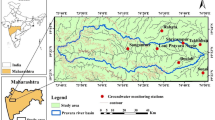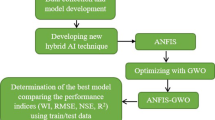Abstract
Prediction of the groundwater level (GWL) fluctuations is very important in the water resource management. This study investigates the potential of two intelligence models namely, Artificial Neural Network (ANN) and Adaptive Neuro-Fuzzy Inference System (ANFIS) in the forecasting of the groundwater level of Bastam Plain in Iran. For this purpose, 9 years data-sets including hydrological and hydrogeological parameters like rainfall recharge, irrigation returned flow and also pumping rates from water wells were used as input data to predict groundwater level. The results showed that ANN and ANFIS models can predict GWL accurately. Also, it was found that the ANFIS model (with root-mean-square-error (RMSE) 0.02 m and determination coefficient (R2) of 0.96) performed better than the ANN model with RMSE = 1.06 m and R2 = 0.83. Finally, three scenarios were considered to predict the groundwater level in the next 2 years as follows 1- The rainfall recharge and pumping rate of water wells will be constant, 2- The rainfall recharge will be constant, but the pumping rate of water wells will be reduced equal to the water deficit of the aquifer, 3- The pumping rate of water wells will be constant but the rainfall recharge will be reduced 30 %. The prediction with these scenarios showed that the groundwater level has the minimum reduction when the pumping rate of water wells is equal to the water deficit of the aquifer.





Similar content being viewed by others
References
Affandi A, Watanabe K (2007) Daily groundwater level fluctuation using soft computing technique. J Nat Sci 5(2):1–10
Akrami SA, Nourani V, Hakim SJS (2014) Development of nonlinear model based on wavelet-ANFIS for rainfall forecasting at Klang gates dam. Water Resour Manag 28:2999–3018
ASCE Task Committee (2000a) Artificial neural networks in hydrology – I: Preliminary concepts. J Hydrol Eng ASCE 5(2):115–123
ASCE Task Committee (2000b) Artificial neural networks in hydrology – II: Hydrologic applications. J Hydrol Eng ASCE 5(2):124–137
Baziar MH, Ghorbani A (2011) Evaluation of lateral spreading using artificial neural networks. Expert Syst Appl 38:5958–5966
Bhattacharjya RK, Datta B (2005) Optimal management of coastal aquifers using linked simulation optimization approach. Water Resour Manage 19:295–320
Bisht D, Mohan Raju M, Joshi M (2009) Simulation of water table elevation fluctuation using fuzzy-logic and ANFIS. Comput Model New Technol 13(2):16–23
Chang F, Chang Y (2006) Adaptive neuro-fuzzy inference system for prediction of water level in reservoir. J Adv Water Res 1(10):1–10
Chaturvedi RS (1973) A note on the investigation of ground water resources in western districts of Uttar Pradesh. annual report, U. P. Irrig Res Inst 1973:86–122
Chen SH, Lin YH, Chang LC, Chang FJ (2006) The strategy of building a flood forecast model by neuro fuzzy network. Hydr Proc 20:1525–1540
Contor, BA (2004) Recharge on non-irrigated lands: Idaho Falls, University of Idaho, Idaho Water Resource Research Institute Technical Report 04–006, 19 p. Available online at URL: ttp://www.if.uidaho.edu/%7ejohnson/DDW003_ NIR_09_1_04.pdf
Coulibaly P, Anctil F, Bobee B (2000) Daily reservoir inflow forecasting using artificial neural networks with stopped training approach. J Hydrol 230:244–257
Coulibaly P, Anctil F, Aravena R, Bobee B (2001) Artificial neural network modeling of water table depth fluctuations. Wat Res 37:885–896
Daliakopoulose NI, Colibaly P, Tsanis KI (2005) Groundwater level forecasting using artificial neural networks. Hydrol 309:229–240
Eberhart RC, Dobbins RW (1990) Neural network PS tools: a practical guide. Academic press, San Diego
Emamgholizadeh S (2012) Neural network modeling of scour cone geometry around outlet in the pressure flushing. Glob Nest J 14:540–549
Emamgholizadeh S, Bateni SM, Jeng DS (2013a) Artificial intelligence-based estimation of flushing half-cone geometry. Eng Appli Arti Intel 26:2551–2558
Emamgholizadeh S, Kashi H, Marofpoor I, Zalaghi E (2013b) Prediction of water quality parameters of Karoon river (Iran) by artificial intelligence-based models. Int J Environ Sci Technol 11:645–656
Esen H, Inalli M (2010) ANN and ANFIS models for performance evaluation of a vertical ground source heat pump system. Exp Sys Appl 37:8134–8147
Gail M, Brion TR, Neelakantan SL (2002) A neural-network-based classification scheme for sorting sources and ages of fecal contamination in Water. Wat Res 36:3765–3774
Ghose D, Panada S, Swain P (2010) Prediction of water table depth in western region, Orissa using BPNN and RBFN neural networks. J Hydr 296–304
Guldal V, Tongal H (2010) Comparison of recurrent neural network, adaptive neuro-fuzzy inference system and stochastic models in Egirdir lake level forcasting. Wat Res Mana 24:105–128
Haykin S (1999) Neural Networks. A Comprehensive Foundation. Second ed. Prentice-Hall, Englewood Cliffs
Jang JSR (1993) ANFIS adaptive-network-based fuzzy inference systems. IEEE Trans Syst Man Cybern 23(03):665–685
Jang JSR, Sun CT, Mizutani E (1997) Neuro-fuzzy and soft computing: a computational approach to learning and machine intelligence. Prentice-Hall International, New Jersey
Karami g. H. (2010). Groundwater draft in Bastam Plain, Shahrood, Iran. In proceeding of the 2010 international conference of Environmental Science and Technology. Editor (s): Saji Baby, Wataniya Environmental Services, Kuwait Parvinder Singh Sandhu, Rayat & Bahra Institute of Engineering & Bio-Technology, India
Karami GH, Bakhshi M, Hosseini H (2009) Evaluating groundwater resources in Shahrood region. In: Doulati Ardejani F (ed) Proceedings of international conference on water resources. Shahrood, Iran, pp 24–32
Kentel E (2009) Estimation of river flow by artificial neural networks and identification of input vectors susceptibble to producing unreliable flow estimates. J Hydr: 481–488
Kisi O (2006) Daily pan evaporation modelling using a neuro-fuzzy computing technique. J Hydrol 329:636–646
Kumar CP, Seethapathi PV (2002) Assessment of natural ground water recharge in upper ganga canal command area. J Appl Hydrol Assoc Hydrol India 4:13–20
Kurtulus B, Razak M (2010) Modeling daily discharge responses of a large karstic aquifer using soft computing methods: artificial neural network and neuro-fuzzy. J Hydrol 381:101–111
Maier HR, Dandy GC (2000) Neural networks for the prediction and forecasting of water resources variables: a review of modeling issues and applications. Environ Model Softw 15:101–124
Matlab 7.1 (2005) Software for technical computing and Model-Based Design. The Math Works Inc
Mohanty S, Jha K, Kumar A, Sudheer K (2010) Artificial neural network modeling for groundwater level forecasting in a river island of eastern India. J Water Resour Manag 24:1845–1865
Moosavi V, Vafakhah M, Shirmohammadi B, Behnia N (2013) A wavelet-ANFIS hybrid model for groundwater level forecasting for different prediction periods. Water Resour Manag 27:1301–1321
Nayak P, Sudheer KP, Rangan DM, Ramasastri KS (2004) A neuro fuzzy computing technique for modeling hydrological time series. J Hydrol 291:52–66
Nayak P, SatyajiRao Y, Sudheer K (2006) Groundwater level forcasting in a shallow aquifer using artificial neural network. J Water Resour Manag 20:77–90
Nourani V, AsghariMoghaddam A, Nadiri A (2008) An ANN-based model for spatiotemporal groundwater level forcasting. J Hydrol Proc 22:5054–5066
Ponnambalam K, Karray F, Mousavi SJ (2003) Minimizing variance of reservoir systems operations benefits using soft computing tools. Fuzzy Sets Syst 139:451–61
Prinos ST, Lietz AC, Irvin RB (2002) Design of a real-time groundwater level monitoring network and portrayal of hydrologic data in southern Floria. US Geological Survey Report 01-4275, US Geological Survey, Tallahassee, FL
Qnet 2000 (1999) Qnet 2000 neural network modelling for windows 95/98/NT, Qnet Toll User’s Guideand Datapro User’s Guide, Vesta Services, Inc., USA
Sanikhani H, Kisi O (2012) River flow estimation and forecasting by using two different adaptive neuro-fuzzy approaches. Water Resour Manag 26:1715–1729
Shirmohammadi B, Vafakhah M, Moosavi V, Moghaddamnia A (2013) Appl Sev Data Driven Tech Predicting Groundw Level Water Resour Manag 27:419–432
Sreekanth PD, Sreedevi PD, Ahmed S, Geethanjali N (2010) Comparison of FFNN and ANFIS models for estimating groundwater level. Environ Earth Sci 62:1301–1310
Trichakis IC, Nikolos IK, Karatzas GP (2011) Artificial neural network (ANN) based modeling for Karstic groundwater level simulation. Water Resour Manage 25(4):1143–1152
Tutmez B, Hatipoglu Z, Kaymak U (2006) Modelling electrical conductivity of groundwater using an adaptive neuro-fuzzy inference system. Compt Rendus Geosci 32:421–433
Yang CC, Prasher S, Lacroxi R (1996) Application of artificial neural network to simulate water-table depths under subirrigation. Cana Water Res J 1–12
Yang CC, Prasher SO, Lacroix R, Sreekanth S, Patni NK, Masse L (1997) Artificial neural network model for subsurfacedrained farmland. J Irrig Drain Eng 123:285–92
Yang ZP, Lu WX, Long YQ, Li P (2009) Application and comparison of two prediction models for groundwater levels; a case study in western Jilin province, China. J Arid Environ 73:487–492
Yarar A, Onucyildiz M, Copty N (2009) Modelling level change in lakes using neuro-fuzzy and artificial neural networks. J Hydrol 365:329–334
Yoon H, Jun SC, Hyun Y, Bae GO, Lee KK (2010) A comparative study of artificial neural networks and support vector machines for predicting groundwater levels in a coastal aquifer. J Hydrol 396:128–138
Author information
Authors and Affiliations
Corresponding author
Rights and permissions
About this article
Cite this article
Emamgholizadeh, S., Moslemi, K. & Karami, G. Prediction the Groundwater Level of Bastam Plain (Iran) by Artificial Neural Network (ANN) and Adaptive Neuro-Fuzzy Inference System (ANFIS). Water Resour Manage 28, 5433–5446 (2014). https://doi.org/10.1007/s11269-014-0810-0
Received:
Accepted:
Published:
Issue Date:
DOI: https://doi.org/10.1007/s11269-014-0810-0




